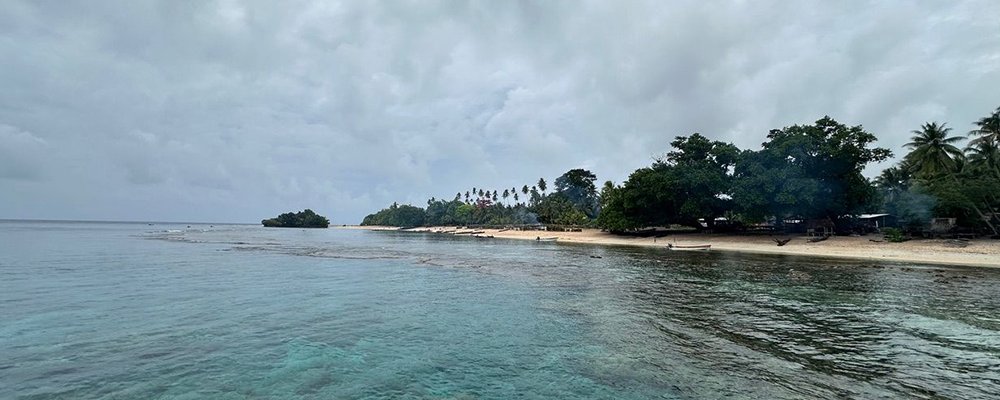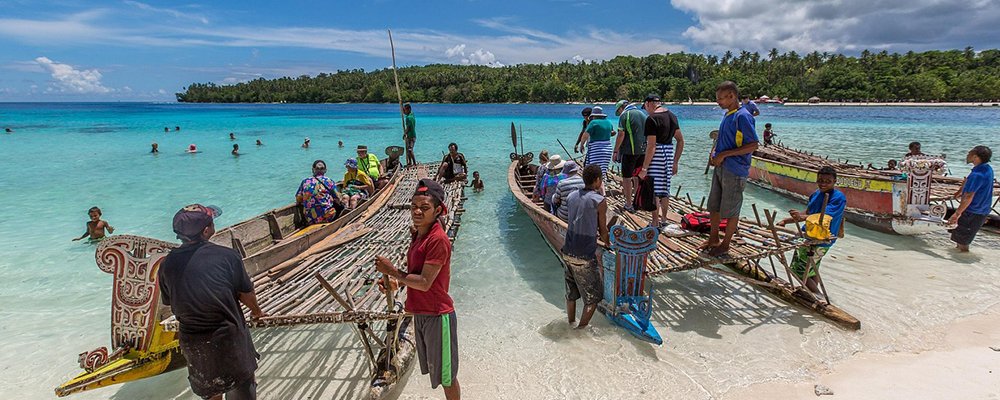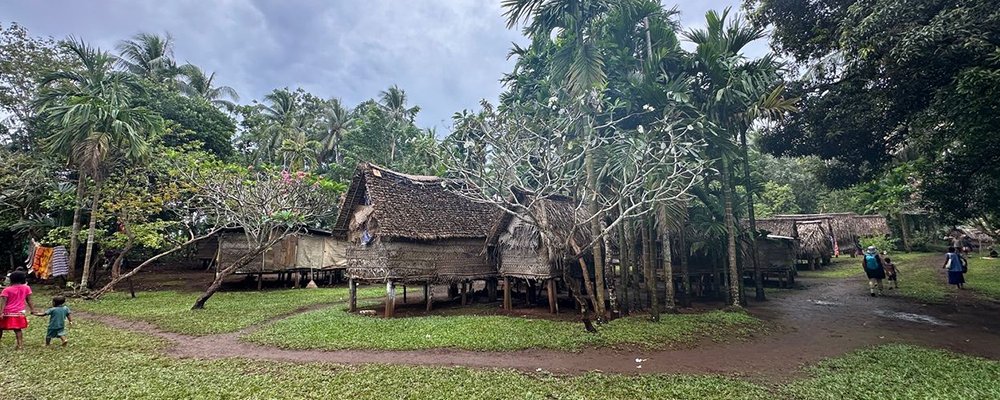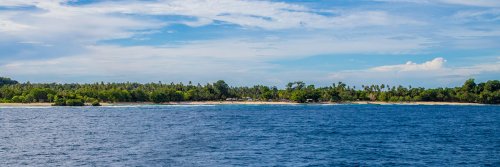Kiriwina Island is located in Papua New Guinea’s Milne Bay Province. With an area of 290.5 km², it is the largest and most populated of the Trobriand Islands - an archipelago of coral atolls off the east coast of New Guinea.
I spent a memorable day at the beautiful beach which is part of Kaibola Village on Kiriwina Island.

Home to a largely unspoiled island culture, the first thing I noticed was the lush, tropical vegetation fringing the crystal-clear water and gorgeous sand beach. I was offered a tour of the Village by a local named Benson. He told me that the society is matrilineal, meaning that the mother’s family line is all important and that land passes to the eldest daughter. (As an eldest daughter, I like this!!)
Benson showed me the villagers’ sleeping huts and their communal kitchen. All the structures are elevated off the ground and the whole village area was scrupulously clean and tidy. The villagers have no electricity nor running water, collecting their water from a nearby spring.
Benson showed me bananas growing wild and small plantings of yams - both staple foods. Pigs wander freely, are hand-reared and slaughtered at feast times.
For an Australian used to all the “mod cons,” the simple, subsistence living was eye-opening to say the least.
I kept passing groups of children, dressed up in colourful, cultural clothing and singing. Their favourite song on repeat was “Twinkle, Twinkle Little Star.” The memories of their delighted faces, wanting only smiles and claps will take a long time to fade.
I visited at low tide so the coral reef was exposed and snorkelling conditions were not ideal but the beach – golden sand and turquoise water - was stunning. I spent some time sitting on the sand in the shade contemplating the meaning of life!

Locals charge about 10 Kina (roughly AUD$5) per person for a ride on a dugout canoe to a neighbouring beach and snorkelling area. A first for me and a lot of fun. Be prepared, though, to get a little wet. (It’s hot so you dry easily!!) Reef shoes would be a good idea as there is a lot of coral to navigate in the water and on the sand.
Having said that, the coral is very delicate and easily damaged so try not to touch it. Also, coral cuts are best avoided – they are painful and can get infected.
After my tour and dugout ride, I wandered around the villagers’ market stalls. Local Kina currency is preferred however Australian dollars may be accepted. Stall after stall sell timber carvings, shells, coral, sarongs, weaved baskets and mats.
Harvesting shells and coral damages the local reefs so please don’t buy them. Instead, support the villagers by buying the carved wooden artworks for which the islands are famous. The craftsmanship is stunning and there is a huge range of carvings to choose from. Some are decorative only and some are functional such as: bowls and platters.
I noticed some turtle poaching too where villagers invite you “to rescue” turtles for a fee. Best not to do this as, unfortunately, paying just perpetuates the poaching.
The school, medical centre and United Church were all seeking donations on the day I visited. If you wish to donate something to Kaibola Village, fishing lines, hooks, school supplies as well as money are all greatly appreciated.

Handy to know:
Climate
Kiriwina Island is hot and humid, maintaining a year-round tropical climate. Daytime temperatures range from 25 to 30 degrees Celsius.
Currency
Credit cards and ATM facilities are not available on Kiriwina Island. Local currency of Kina is accepted. Australian dollars are also accepted but exchanging Australian dollars is expensive for the locals.
Communication
There are no public telephones and no internet access available in Kiriwina.
I enjoyed being “off-grid.” There is a serenity that comes with not being connected to email and social media for a few hours.
Note - there is no holiday accommodation at Kaibola Village. Make sure that you have your return transport organised before you are dropped off given that you will not have mobile phone access.
What to wear
To make your day trip as enjoyable as possible, be sure to wear comfortable shoes, lightweight, sun-smart clothing and a hat.
What to take with you
Bring sunscreen, insect repellent, reef shoes, snorkelling gear, food (at least snacks) and bottled water. There is no food nor drinks available to buy so you need to bring food and drinks with you.
Ideally, bring water in a reusable bottle. Plastics are discouraged due to the environmental risks in such a pristine environment.
Take all your rubbish with you. As the saying goes, take photos and leave only footprints.
Leonie Jarretti, an avid traveller, lives in Melbourne, Australia with her Husband of more than 3 decades, her 4 adult children and her 2 Golden Retrievers. Follow Leonie here.















